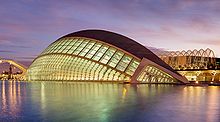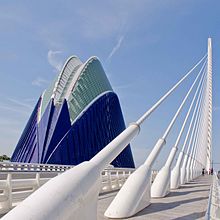- Ciutat de les Arts i les Ciències
-
File:Ciudad de les Arts y les Ciències.jpgCiutat de les Arts i les CiènciesFile:Ciudad de les Arts y les Ciències - L'Umbracle.jpgL'Umbracle
The City of Arts and Sciences (Valencian: Ciutat de les Arts i les Ciències, Spanish: Ciudad de las Artes y las Ciencias) is an entertainment-based cultural and architectural complex in the city of Valencia, Spain. It is the most important modern tourist destination in the city of Valencia.
The City of Arts and Sciences is situated at the end of the old riverbed Turia. Turia became a garden in 1980, after the bypass of the river by the great flood of Valencia in 1957.
Designed by Santiago Calatrava and Félix Candela, the project underwent the first stages of construction in July 1996 and the finished "city" was inaugurated April 16, 1998 with the opening of L'Hemisfèric. The last great component of the City of Arts and Sciences, El Palau de les Arts Reina Sofia, was presented on October 9, 2005, Valencian Community Day.
Contents
Buildings
The complex is made up of the following buildings, in order of their inauguration:
- L'Hemisfèric — an Imax Cinema, Planetarium and Laserium. The building is meant to resemble a giant marine isopod, and has an approximate surface of 13,000 m².
- El Museu de les Ciències Príncipe Felipe — an interactive museum of science but resembling the skeleton of a whale. It occupies around 40,000 m² on three flats.
- L'Umbracle — a landscaped walk with plant species indigenous to Valencia (such as rockrose, lentisca, romero, lavender, honeysuckle, bougainvillea, palm tree). It harbors in its interior The Walk of the Sculptures, an outdoor art gallery with sculptures from contemporary artists. (Miquel from Navarre, Francesc Abbot, Yoko Ono and others).
- L'Oceanogràfic — an open-air oceanographic park. It is the largest oceanographic aquarium in Europe with 110,000 square meters and 42 million liters of water. It was built in the shape of a water lily and is the work of architect Félix Candela.
- El Palau de les Arts Reina Sofia — an opera house and performing arts center. It contains four large rooms: a Main Room, Magisterial Classroom, Amphitheater and Theater of Camera. It is dedicated to music and the scenic arts.
- El Puente de l'Assut de l'Or — a bridge that connects the south side with Minorca Street, whose 125 meters high pillar is the highest point in the city.
- L'Àgora — a covered plaza in which concerts and sporting events (such as the Valencia Open 500) are held.[1]
- The Valencia Towers — forming part of a project of the construction of three skyscrapers of 308, 266 and 220 m. The project has been put on hold and the possibilities that it will be finished are seen by many as doubtful.
History
Origins of the project
In 1989, the then president of the Valencian Generality, Joan Lerma, took up the idea of José María López Piñero, professor of the history of science at the University of Valencia, to build a scientific museum on the land of the Garden of the Turia River that bordered the road with mulberry trees. Lerma entrusted the creation of a team that articulated the project and that visited spaces with similar characteristics in Munich, Canada and London, to devise a project of evident pedagogical appearance.
The "City of the Sciences" was the name that the autonomous government gave to the initiative, and plans included a 370m high communications tower, which would have been the third highest one in the world at that time; a planetarium; and the museum of science. The total price of the works was estimated to be about 25,000 million pesetas, or about 150 million euro.
The project did however cause controversy. The Popular Party saw in the City of the Sciences a "work of the pharaohs" that would serve only to swell the ego of the socialists, who were the driving forces behind the initiative. The communications tower was the main object of criticism. Nonetheless, work continued.
Construction
In May 1991, the council approved the transfer of lands. Four months later the project was presented, designed by Santiago Calatrava. Construction began by the end of 1994.
The team that had designed the museum did not see eye to eye with the form in which Santiago Calatrava conceived the building. Therefore, a couple of changes were made.
Inauguration
In April 1998 the complex opened its doors to the public with L'Hemisfèric. Eleven months later, the president of Valencia, Eduardo Zaplana, inaugurated the Prince Felipe Museum of the Sciences, although the museum was not yet finished. The museum was opened to the public twenty months later. December 12, 2002 was the opening of L'Oceanographic, the largest aquarium built in Europe. Finally, on October 8, 2005 the Palau de les Arts Reina Sofía was opened and became the opera house of Valencia.
See also
- Valencia, Spain
- 12 Treasures of Spain
References
External links
- Official website
- Official tourism website of Valencia
- Ciutat de les Arts i les Ciències at Google Maps
Coordinates: 39°27′16.30″N 0°21′01.31″W / 39.454528°N 0.3503639°WCategories:- Buildings and structures completed in 1998
- IMAX venues
- Santiago Calatrava structures
- High-tech architecture
- Lattice shell structures
- Modernist architecture in Spain
- Science museums
- Buildings and structures in Valencia
- Event venues established in 1998
Wikimedia Foundation. 2010.





